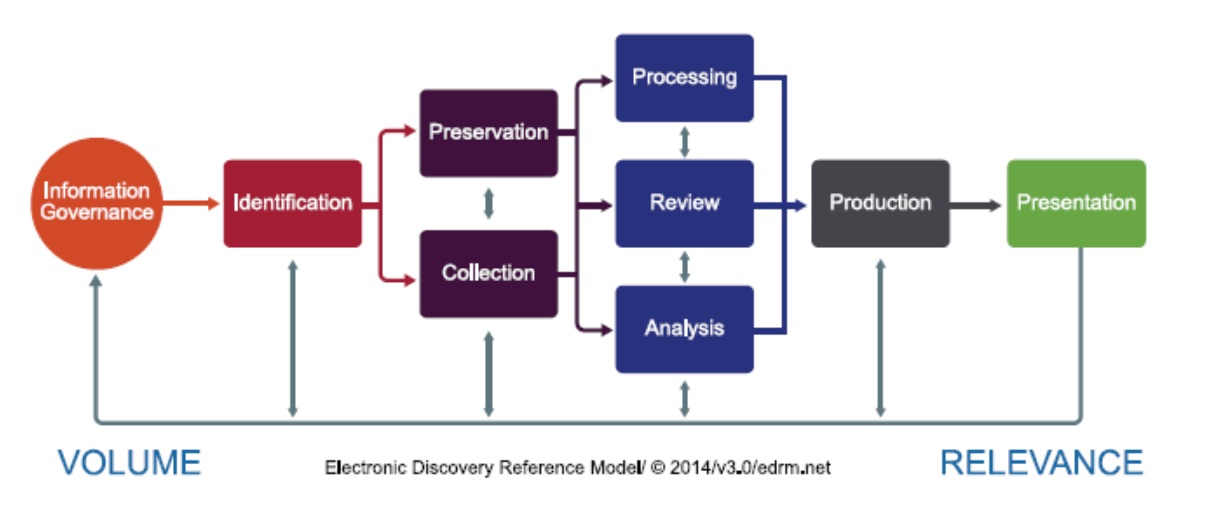In a business environment dominated by data, electronic discovery (eDiscovery) has emerged as a critical component of legal proceedings. Consequently, corporate leaders must understand and streamline the eDiscovery process to ensure compliance, minimize risks, and reduce costs. The following guidelines for the electronic discovery process provide an essential starting point.
In a nutshell, eDiscovery includes the following steps:
- Identification – Search throughout the organization for all electronically stored information (ESI) potentially relevant to the case at hand.
- Preservation – Once you have identified potentially relevant data, place legal holds to prevent any alteration or destruction of that data.
- Collection – Gather the data in a way that ensures it maintains its integrity and security.
- Processing – Organize the collected data, eliminate redundant or irrelevant information, and convert it into a reviewable format. Additionally, make sure to redact sensitive information, specifically in compliance with regulations such as Daniel’s Law, HIPAA, and other regulations that require protection of personally identifiable information (PII).
- Review and analysis – Legal teams analyze the information to extract insights and patterns and determine its relevance to the legal matter at hand.
- Production – Deliver relevant ESI to the requesting party in the agreed-upon format.

This process can prove both time-consuming and costly. However, several best practices ease the process and can even help you turn eDiscovery into a competitive advantage for your organization.
Proactively Manage Data
Legal cases can mean data requests involving millions of documents in numerous formats, from emails to word processing documents, voicemails, social media, meeting minutes, and more. Massive amounts of data can easily make the process overwhelming. Further, a complex regulatory environment mandates strict security and privacy controls.
Proactive organizations implement solid information governance ahead of time to ease the process, beginning with an inventory of all data sources in the organization. Next, a data quality assessment highlights outdated information and duplicates. Resolving data quality issues before a legal matter arises will make it easier to identify relevant data.
Data classification and metadata management also play a significant role in information governance. Labeling data as sensitive or relevant to a particular topic allows the organization to monitor the information and ensure proper retention and security. And finding the goldilocks zone for data retention will prove essential.
Develop an eDiscovery Strategy Ahead of Time
Without a strategic approach, your organization can face delays, increased costs, and even legal sanctions. Therefore, do not wait until an eDiscovery request lands on your doorstep to establish an eDiscovery plan. Instead, build a clear and detailed eDiscovery policy now, before a legal matter appears on the radar.
A comprehensive eDiscovery plan should outline procedures for data preservation and legal holds, as well as collection, review, and production of ESI. Documenting these procedures can help demonstrate compliance with legal requirements and may prove invaluable if the process is challenged in court.
The eDiscovery plan should also define roles and responsibilities within the organization for managing eDiscovery tasks. This will include personnel from both IT and the legal department, as well as data custodians. Larger organizations may also identify eDiscovery specialists and forensic experts.
Preserve Relevant Data
Failing to preserve relevant data can lead to accusations of data spoliation, which can severely impact a case. Thus, as soon as litigation is reasonably anticipated, organizations must move quickly to place legal holds preventing deletion or modification of potentially relevant information.
Using legal technology, the corporation can automate the process of legal holds and instantly preserve data in place. This automation saves time while improving defensibility and reducing the risk of sanctions.

Leverage eDiscovery Technology Wisely
Automated legal holds represent just one example of useful eDiscovery technology. For instance, cloud-based eDiscovery solutions offer scalability and efficiency at a lower cost. Additionally, automated early case assessment (ECA) plays a critical role in helping legal teams rapidly identify and prioritize relevant data.
Workflow automation offers another opportunity to streamline the process. Customized workflow templates for common scenarios like data review help the team avoid re-inventing the wheel with each new case.
Finally, end-to-end legal technology solutions simplify the process from data collection through review and production. Whether conducting an ECA or a full document review, these tools combine comprehensive data collection and processing with critical data security.
Additional Guidelines for the Electronic Discovery Process
Information governance and a strategic approach set the foundation for a successful, defensible eDiscovery process, assisted by wisely utilized technology. But other factors play important roles, as well.
For instance, organizations need to ensure effective collaboration among legal, IT, and business teams. And they need to teach employees the importance of eDiscovery and train them on the specific procedures they must follow.
Above all, when faced with an eDiscovery request, the organization must respond promptly and efficiently, ensure defensible data collection, and maintain a clear chain of custody for all information.
The eDiscovery experts at Messaging Architects combine best-in-class legal technology solutions with years of experience. We can help you ensure comprehensive information governance and data security and deliver the support you need to smoothly navigate the eDiscovery process.







